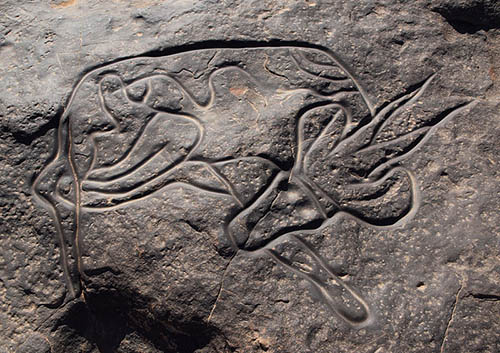

In the history of art, prehistoric art is all art produced in preliterate, prehistorical cultures beginning somewhere in very late geological history, and generally continuing until that culture either develops writing or other methods of record-keeping, or makes significant contact with another culture that has, and that makes some record of major historical events. At this point ancient art begins, for the older literate cultures. The end-date for what is covered by the term thus varies greatly between different parts of the world.
The very earliest human artifacts showing evidence of workmanship with an artistic purpose are the subject of some debate; it is clear that such workmanship existed by 40,000 years ago in the Upper Paleolithic era. From the Upper Paleolithic through the Mesolithic, cave paintings and portable art such as figurines and beads predominated, with decorative figured workings also seen on some utilitarian objects.
In the Neolithic evidence of early pottery appeared, as did sculpture and the construction of megaliths. Early rock art also first appeared in the Neolithic. The advent of metalworking in the Bronze Age brought additional media available for use in making art, an increase in stylistic diversity, and the creation of objects that did not have any obvious function other than art. It also saw the development in some areas of artisans, a class of people specializing in the production of art, as well as early writing systems. By the Iron Age, civilizations with writing had arisen from Ancient Egypt to Ancient China.
Many indigenous peoples from around the world continued to produce artistic works distinctive to their geographic area and culture, until exploration and commerce brought record-keeping methods to them. Some cultures, notably the Maya civilization, independently developed writing during the time they flourished, which was then later lost. These cultures may be classified as prehistoric, especially if their writing systems have not been deciphered. Read more ...
A tiny head carved from mammoth ivory looks back at us from the Stone Age. The tiny head carved from mammoth ivory may be the oldest known depiction of a human Live Science - February 3, 2025
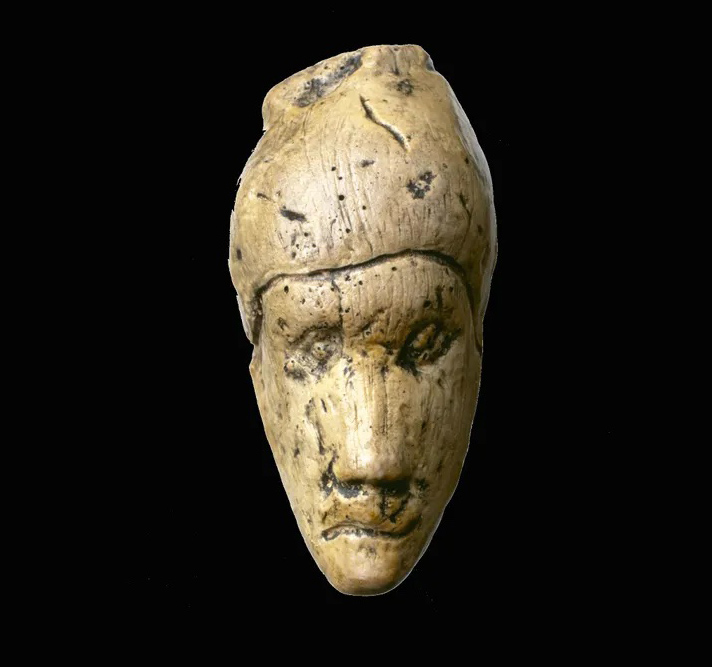
This sculpture, discovered at the archaeological site of Dolni Vestonice in the Czech Republic in the 1920s, is considered the oldest surviving portrait of a person anywhere in the world, at 26,000 years old.
Red dot becomes 'oldest cave art' BBC - June 14, 2012
The El Castillo Cave in Spain -- The refined dating shows these paintings to be far older than anyone thought. Red dots, hand stencils and animal figures represent the oldest examples yet found of cave art in Europe. The symbols on the walls at 11 Spanish locations, including the World Heritage sites of Altamira, El Castillo and Tito Bustillo have long been recognized for their antiquity. But researchers have now used refined dating techniques to get a more accurate determination of their ages. One motif - a faint red dot - is said to be more than 40,000 years old.
New dating method shows cave art is older: Did Neanderthals do it? MSNBC - June 14, 2012
When archaeologists tried out a new technique to determine the age of Spain's most famous Paleolithic cave paintings, they were surprised to discover that the paintings were thousands of years older than previously thought - so old that it's conceivable they were painted by Neanderthals. The technique just might change the way we think about the paintings, and the way we think about our long-extinct, long-maligned Neanderthal cousins as well.
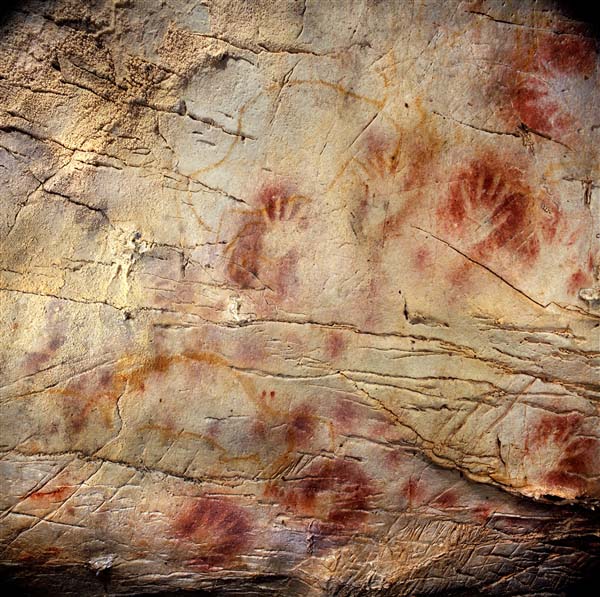
Hand stencils and the outlines of animals dominate "The Panel of Hands" in Spain's El Castillo cave. One of the stencils has been dated to earlier than 37,300 years ago, and a red disk goes back at least 40,800 years, making them the oldest cave paintings in Europe.
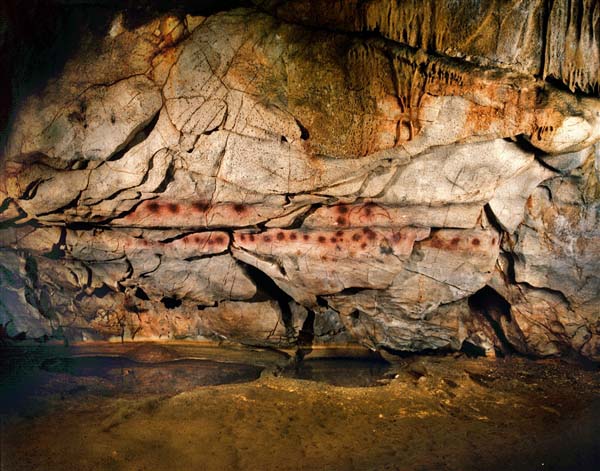
The "Corredor de los Puntos" lies within Spain's El Castillo cave. Red disks here have been dated to between 34,000 and 36,000 years ago, and elsewhere in the cave to 40,800 years ago, making them examples of Europe's earliest cave art.
New dating method shows cave art is older: Did Neanderthals do it? NBC - June 14, 2012
When archaeologists tried out a new technique to determine the age of Spain's most famous Paleolithic cave paintings, they were surprised to discover that the paintings were thousands of years older than previously thought - so old that it's conceivable they were painted by Neanderthals. The technique just might change the way we think about the paintings, and the way we think about our long-extinct, long-maligned Neanderthal cousins as well.
Oldest Art Even Older: New Dates from Geibenklosterle Cave Show Early Arrival of Modern Humans, Art and Music Science Daily - May 24, 2012
Researchers from Oxford and Tubingen have published new radiocarbon dates from the from Geibenklosterle Cave in Swabian Jura of Southwestern Germany in the Journal of Human Evolution. The new dates use improved methods to remove contamination and produced ages between began between 42,000 43,000 years ago for start of the Aurignacian, the first culture to produce a wide range of figurative art, music and other key innovations as postulated in the Kulturpumpe Hypothesis. The full spectrum of these innovations were established in the region no later than 40,000 years ago.
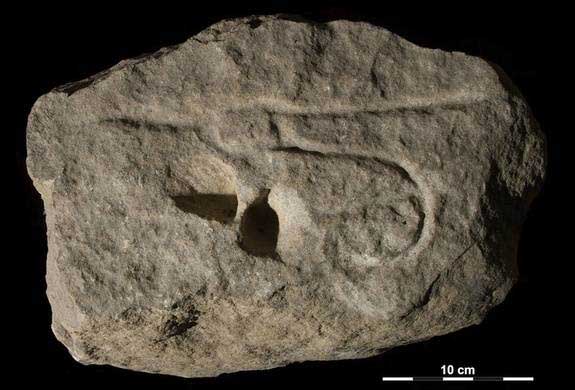
Female Genitalia Carvings Are Europe's Oldest Rock Art Live Science - May 14, 2012
The oldest rock art ever found in Europe reveals an interest in the female form - and the type of decor that the first Europeans preferred for their living spaces. The new discovery, uncovered at a site called Abri Castanet in France, consists mainly of circular carvings most likely meant to represent the vulva. The carvings were etched into the ceiling of a now-collapsed rock shelter about 37,000 years ago. The artists who created this ceiling decor were the first humans in Europe, a group called the Aurignicians. Arriving from Africa, they would replace the Neanderthals in Eurasia.
Anthropologists Discover Earliest Form of Wall Art Science Daily - May 14, 2012
Anthropologists working in southern France have determined that a 1.5 metric ton block of engraved limestone constitutes the earliest evidence of wall art. Their research, reported in the most recent edition of the Proceedings of the National Academy of Sciences, shows the piece to be approximately 37,000 years old and offers rich evidence of the role art played in the daily lives of Early Aurignacian humans. The research team, composed of more than a dozen scientists from American and European universities and research institutions, has been excavating at the site of the discovery -- Abri Castanet -- for the past 15 years. Abri Castanet and its sister site Abri Blanchard have long been recognized as being among the oldest sites in Eurasia bearing artifacts of human symbolism. Hundreds of personal ornaments have been discovered, including pierced animal teeth, pierced shells, ivory and soapstone beads, engravings, and paintings on limestone slabs.
Ancient 'paint factory' unearthed BBC - October 14, 2011
The kits used by humans 100,000 years ago to make paint have been found at the famous archaeological site of Blombos Cave in South Africa. The hoard includes red and yellow pigments, shell containers, and the grinding cobbles and bone spatulas to work up a paste - everything an ancient artist might need in their workshop. These finds indicate that humans were certainly thinking in a modern way, in a way that is cognitively advanced, at least 100,000 years ago.
Scientists reveal a first in Ice Age art PhysOrg - June 21, 2011
Researchers from the Smithsonian Institution and the University of Florida have announced the discovery of a bone fragment, approximately 13,000 years old, in Florida with an incised image of a mammoth or mastodon. This engraving is the oldest and only known example of Ice Age art to depict a proboscidean (the order of animals with trunks) in the Americas.
Italy: Primitive Cinema Used Echoes and Rock Engravings Live Science - July 8, 2010
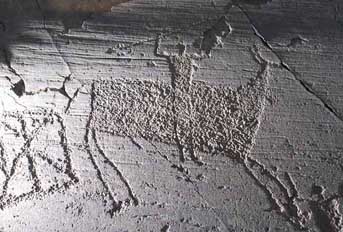
Prehistoric man enjoyed a primitive version of cinema PhysOrg - June 29, 2010
>
The ancient Aboriginal rock carving known as 'Climbing Man' is shown in this photo taken on the Burrup Peninsula in Australia in 2008.
Religious beliefs are the basis of the origins of Palaeolithic art PhysOrg - March 26, 2010
Stone man joins carved animals in neolithic farmyard Guardian - September 10, 2009
The figurine was dug up at the ancient site of Catalhoyuk in Turkey, which is thought to have been home for some of the world's first farmers. A reclining man with a bushy beard and big nose is the latest to join a haul of stone figurines unearthed at the ancient site of Catalhoyuk in Turkey. The sculpture, which measures around six inches high, was uncovered at the neolithic site last week. Catalhoyuk was the final resting place of some of the world's first farmers. Other figurines representing farmyard animals and people in sitting and standing positions have already been excavated at the site, which dates back to the dawn of farming some 9,000 years ago. Archaeologists working on the site have discovered primitive houses with rooms decorated with vulture skulls, wild boar tusks and teeth from weasels and foxes. Some of the buildings are believed to have humans buried beneath them.
Ancient stone artwork discovered BBC - August 18, 2009
Prehistoric artwork has been discovered by an amateur archaeologist at a Perthshire mountain range. The ancient carvings were discovered by rock art enthusiast George Currie at Ben Lawers, near Loch Tay. Mr Currie discovered a piece of rock which has more than 90 cup marks, which are circular depressions in the stone.
Some of the cups have rings around them and a number of linear grooves can also be seen, with some still showing the individual blows of craftsmens' tools. Similar discoveries have been made in the area, but it is unusual to find so many markings on the one stone. The purpose of the artworks are still unknown. Derek Alexander, archaeologist for the National Trust for Scotland, said: "This is an exciting find as it shows that there remains undiscovered prehistoric rock art to be found in the Scottish hills.
Obsession with Naked Women Dates Back 35,000 Years Live Science - May 13, 2009
Sexy "Venus" may be oldest figurine yet discovered. Radiocarbon dating indicates the figure excavated from an archaeological dig in southern Germany, near the Danube valley, was at least 35,000 years old.
Australia: Cave Painting Depicts Extinct Marsupial Lion Live Science - May 11, 2009
Modern Australia lacks big land predators, but until about 30,000 years ago, the continent was ruled by Thylacoleo carnifex, the marsupial "lion." Several well-preserved skeletons of the leopard-size beast have been found. Now, a newly discovered cave painting offers a glimpse of the animal's external appearance.
New Stone Age artefacts unearthed BBC - December 1, 2008
The carving has a feminine form, reminiscent of Venus figurines found from Siberia to the Pyrenees. Rare artefacts from the late Stone Age have been uncovered in Russia. The site at Zaraysk, 150km south-east of Moscow, has yielded figurines and carvings on mammoth tusks. The finds also included a cone-shaped object whose function, the authors report in the journal Antiquity, "remains a puzzle". Such artistic artefacts have been found in the nearby regions of Kostenki and Avdeevo, but this is the first such discovery at Zaraysk. The Upper Palaeolithic (roughly 10,000-40,000 years ago) is the period during which humans made the transition from functional tool-making to art and adornment.